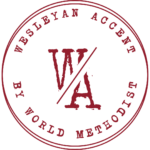I Am Who The I AM Says I Am (Part 2) by Dave Smith

This is part II of a five part article outlining a Wesleyan Anthropology arising from a Biblical Worldview. (Check out Part I here) Originally an oral presentation for the Wesleyan Church, it has been revised and updated for a broader Wesleyan Methodist audience.
What is our cosmology?
When my son Joshua was very young and I would put him to bed at night, he would say this, “Daddy, tell me a story. BUT make sure to get me into it.”
We are indeed people of story. But first and foremost, we need an orienting story. A compelling story from which to stand and gaze upon the beautiful world.
Genesis 1-2 is just such a story, a revelation, told by the One who was there from the beginning. Let’s summarize this Creation event with the foundational orienting principles for our story.
A Temple Text: The Creation of Heaven and Earth
Any person from the Ancient Near East would recognize that this narrative is not merely about God creating material things. It was not seen as an argument of science (evolution) versus Faith until recent days. No! Genesis 1 is a text about the creation of a temple (see John Walton, George Beale, Sandra Richter). This is the story of God creating the Heaven and the Earth as His domain in which He will rule. On the 7th Day, God (Elohim) sits down on His throne to rule. Let’s be clear, He is not tired from Creating. Rather, He now “rests” from the work He has done. The word “rest” has royal implications. He rules from heaven and the earth is His footstool (Ps 2, Ps 110). Heaven and earth are to be seen as wonderfully interweaving and overlapping. They are to be seen as One just as we and the Creator God are to be One. Unity is part of creation and new creation. And of course, the last thing done with the creation of a temple in the ANE is to place an Image of the God in the Temple. That would be Adam and Eve, that would be you and me. First orienting truth: Genesis 1 is a Temple Text; and we are His “Icons” in the middle of this orienting story.
Humans as Divine Image-Bearers
Humans are created to reflect the Image and Likeness of the King. The text of Gen 1:26-28 tells us three times; humanity (we) are created to rule-to subdue-to rule. Genesis 2, utilizing the covenant name YHWH Elohim, reports to us that in the Garden, we are to “work it” and to “take care of it.” Profoundly, this is the same job description given to the priests as they served/worshiped in the Tabernacle in the wilderness and later in the Temple in Jerusalem. Our vocation (or if you prefer the designation “our calling”) to be rulers can be best defined as this: to reflect the Imago Dei into the world as we care for our Eden. May people see God in us as we live in the “Eden” where God has placed us. In John Chapters 1-12, 3x’s Jesus says, “I only do what I have seen the Father do. Equally, 3x’s he says, “I only say what I have heard the Father say.” This is the model for Adam-Eve as they rule, and for us as well. Paul calls this being “Christ-like.” The second orienting truth: We are to rule-care for Creation in the precise manner that God reigns from Heaven.
Defining Good and Evil
God declares His creative acts as “Good” six times. With the creation of humans, He ups the critique, calling us “very good.” Take note that in Genesis 2:9, we are told that out of the ground, God causes to grow “fruit bearing trees that are pleasant for sight and good for food.” It is God who defines what trees are good and what are evil. This is not Adam or Eve’s role. Nor is it ours. God’s orienting story defines “good” this way, “it functions and operates according to God’s intention.” Conversely, when we push back against God’s definition of “Good”, we are not merely naughty children; we are literally un-creating God’s good order. May I humbly interject, this has everything to do with how a small yet vocal part of our society is re-writing time-honored definitions of “goodness.” Let’s not interpret this as humanity growing and progressing. Rather, we are regressing into rebellion once more, causing dysfunction to reign. The orienting story of Gen 1-2 is not primarily about God “making material things.” Rather, The Lord is speaking and ordering things according to His revelation of “Good.” Our third orienting truth: We are entrusted to rule “our Eden-like place” but God gets the final say on what is good and what is evil.
What is Our Anthropology?
The second question upon which our story is created is this: Who are we? What is our anthropology?
Allow me to briefly interject a few Wesleyan moorings upon this theological question.
First thought, “Does your anthropology begin at Genesis 3 or does it take seriously the orienting story of Genesis 1 and 2? Is “being human” defined by what he/she does or how God originally created them as Image Bearers and godly rulers? Many of our Reformed brothers and sisters see “humans-as-sinners” in word, thought, and deed; every minute of every day. Moreover, their approach to this sin problem will not be taken care of until we are “glorified.” This theological position reveals our vast anthropological differences. Here are three examples which should be fleshed out to fully grasp the Wesleyan story.
Imputed vs. Imparted Righteousness
Imputed vs Imparted Righteousness. Yes, this is both a mouthful and a mind-full. In short, imputed righteousness states that a believer would only “appear” righteous as he/she stands before God; not fully made new. The narrative should be told with the full restoration of the Imago Dei in view. Imputed Righteousness has justification at the core; think “positional holiness”. Imparted righteousness points to the work that sanctification accomplishes; think “personal or actual holiness” (see 2 Cor 5:21, “For our sake he made him to be sin who knew no sin, so that in him we might become the righteousness of God.”)
Freedom from Sin: Now or Later?
In this lifetime, only freedom from the guilt of sin but not from the power of sin. The curse will not be reversed until the eschaton and not in the here and now. Our position is that in Jesus, New Creation has already begun; thus, the curse is being reversed. There are huge ramifications to this reality. Let’s look at one key aspect with reference to our story; our egalitarian position vs the generic evangelical view of a complementarian. The undergirding theological difference is this, “Has the life, suffering, death, Resurrection, Ascension of Jesus, plus the coming of the Spirit at Pentecost reversed the curse?” If not, we must ask, “What is lacking in the work of Jesus that the reign of the fall remains intact between men and women?” Nothing is lacking! We must live in the “It is Finished-ness” of Christ’s redeeming work. The reality that all humans have once again been declared equal (see, Galatians 3:28). This is a significant element in our story and the tradition of the Wesleys. Our position on this issue reveals so much of our stand on the completeness of salvation and our renewed ecclesiology based upon Pentecost as the climax of Christ’s work and not just Easter (Acts 2: Holy Spirit coming upon men AND women).
The Danger of De-Humanized Anthropology
Second thought is that we have often unknowingly bought into a de-humanized anthropology. We graciously excuse sinful behavior with the sarcastic remark, “Sorry. I was just being human.” May that never come from our mouths. Our anthropology must be based upon the revelation of who Jesus is as a model human being. Anything else “falls short of the glory of God.” And glory is, in part, what we are to reflect through the Imago Dei. Read Psalm 8:
1Lord, our Lord, how majestic is your name in all the earth! You have set your glory in the heavens.
4 what is mankind that you are mindful of them, human beings that you care for them?
5 You have made them a little lower than the angels (gods?) and crowned them with glory and honor.
6 You made them rulers over the works of your hands; you put everything under their feet: (see Ps 2)
9 Lord, our Lord, how majestic is your name in all the earth!
Reflecting God’s Glory
In Jesus’ priestly prayer of John 17, the exchange of “glory” is one of the primary topics. The prayer begins, “Father, the hour has come. Glorify Your Son, that Your Son may glorify You.” (17:1) Jesus continues, “I have brought You glory on earth by finishing the work You gave Me to do. And now, Father, glorify me in your presence with the glory I had with you before the world began (17:4-5). The Father and the Son mutually exchange glory.
Now begins the plot twist which makes this our most compelling part of the story, “All I have is Yours, and all You have is mine. And glory has come to me through them. (17:10). People. Humans. The disciples bring glory to Jesus.
The Trinitarian Wesleyan Anthropology
Finally, the John 17 prayer transitions from Jesus praying for His 12 Disciples to His intercession for “all those who will believe in Jesus because of the message of the disciples” (aka, that would certainly include you and me). Shockingly, Jesus prays, “I have given them the glory that You gave to Me – that they may be One as We are One – so that they may be brought to complete unity.” This is the new creation plan of the Father and the Son; for us. This is a Trinitarian Wesleyan Anthropology.
Our Role in God’s Grand Story
But the prayer does not climax there. Jesus explicitly reveals the purpose for us reflecting the Glory of God, “Then the world will know that you sent me and have loved them even as you have loved me.” Yes, the World will be transformed by seeing God’s Glory in us. You may say Jesus’ understanding of the human mission is too hopeful. Is too good. Maybe our anthropology is simply too small.
Embracing Our Divine Narrative
There are many stories in the world, both ancient and modern, that discuss what it means to be a human being. Anything that falls short of Jesus and His glory, is not compelling enough. Let’s listen carefully as the world tells their stories based upon human brokenness and disorder. Then let’s proclaim clearly, graciously and a little salty the Biblical story. Jesus gets His opportunity to tell His Story, through us. Yes, (1) through His Word, (2) the convicting Holy Spirit and (3) by us as His Image Bearers. We will glorify Him. Anything that falls short of this is inadequate to explain a proper anthropology.
Subscribe
Get articles about mission, evangelism, leadership, discipleship and prayer delivered directly to your inbox – for free



